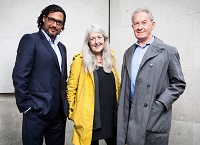| Civilisations & Civilisation: 2018 versus 1969 |
Television Arts Feature |
| Civilisations , BBC , April 30, 2018 |
 Civilisations (2018) and Civilisation (1969) both have books to accompany the television series. The book by Mary Beard, a scholar of distinction, is resolutely unscholarly in tone. Thus, while wholly admiring of a vase from Greek antiquity, her observation on its imagery reads: “may be tempting to spot here the equivalent of the modern health warning on the cigarette packet”. The judgements do not have the summary robustness of the art historian. In front of the paintings at Ajanta her text reads: “Religion often trades on complexity.” She continues that religion “exploits the fact that belief can be configured in different ways and that there is always a gap between faith and knowledge.” This is not so for the devout, faith and knowledge forming a unity.
Civilisations (2018) and Civilisation (1969) both have books to accompany the television series. The book by Mary Beard, a scholar of distinction, is resolutely unscholarly in tone. Thus, while wholly admiring of a vase from Greek antiquity, her observation on its imagery reads: “may be tempting to spot here the equivalent of the modern health warning on the cigarette packet”. The judgements do not have the summary robustness of the art historian. In front of the paintings at Ajanta her text reads: “Religion often trades on complexity.” She continues that religion “exploits the fact that belief can be configured in different ways and that there is always a gap between faith and knowledge.” This is not so for the devout, faith and knowledge forming a unity. She visits India, Mexico, Cambodia but she and Kenneth Clark also overlap. They are both in Ravenna and the difference is telling. In the church of San Vitale she observes: “the mosaics add up to a very strong case for the divine status of Jesus as if to erode any misunderstanding.” This is lightweight. By contrast Clark conveys the location with vividness, recounting that Charlemagne visited after his coronation in Rome in 800. The experience inspired his commissioning of the Byzantine-style octagon that is now the east end of Aachen's cathedral. Clark is superior in one respect over the nine hours of television of 2018. The vessel of culture is language. Humanity is a language-carrying species. Other species communicate with complexity; none has developed anything like the fifty million variations of meaning that the human vocal cords emit. Clark's interpretation of the visual arts is suffused with words. In his interpretation texts, opinions, critiques are intertwined with the making of images. This relationship starts from his beginning. He is at the Pont du Gard. The Romans had architecture where the Huns were illiterate. The Renaissance had the balance sheet, its inventor Luca Pacioli being a friend of Leonardo. Clark illustrates the relationship of language and art taking different forms. St Bernard of Clairvaux takes his cue from Plato and speaks of the “lies of poetry”. In the cloisters it is different: “there appears on all sides so rich and amazing a variety of forms that it is more delightful to read the marble than the manuscripts and to spend the whole day admiring these things.” More commonly the written word is instrumental for the art. Clark describes Abbot Suger ordering the translation of “the Heavenly Hierarchies”. This was a treatise written by Denis who had been converted by St Paul. “The dull mind rises to truth through that which is material”, said Suger. He went on to be the initiator of the clerestory, the triforium, the rose window. Botticelli is clearly not Giotto and Clark points to why. The jump in the intellectual background is considerable. “Primavera” took its subject from Ovid. “The Birth of Venus” owed its origin to a neo-Platonist poet, Poliziano. Centuries on, he describes how Turner, with hardly any education, painfully made his way through Goethe's “Theory of Colour”. Goethe at the time was held in equal standing with Newton. Clark's journey through the centuries never moves far from this interconnectedness of writers and artists. He cites Dante's line of “the light of dawn, on the sea, on leaves in spring” to illuminate the painting of the age. Erasmus knew Holbein well and the artist both read and painted him. Descartes lived in Haarlem near to Frans Hals and was his subject for a portrait. John Evelyn at the opera in Rome in 1644 reported that Bernini “painted the scenes, cut the statues, invented the engines, composed the music, wrote the comedy and built the theatre.” Lawrence Sterne's criticism illuminates Watteau. Olusoga, Beard and Schama have interesting things to say and to show. But they are the equal of their predecessor rather than his superior. A simple reading of history might date the decline of religion to Matthew Arnold and “Dover Beach.” Clark cites Montesquieu to the effect: “There is no religion in England. If anyone mentions religion people begin to laugh”. That was in 1730. Clark may draw on high philosophy from the likes of John of Salisbury. The age of aristocratic excess had its commentators too. Montaigne is deathless. “Sit we upon the highest throne”, Clark reminds his audience, “yet sit we only upon our own tail.” Clark's book holds up well at 49 years of age. Posterity will make its own judgement in 2067 on the publications of today. “Civilisations” is available on BBC iPlayer Kenneth Clark “Civilisation” BBC & John Murray: London, 1969 Mary Beard “The Eye of Faith”/ “How Do We Look?” Profile: London 2018 |
Reviewed by: Adam Somerset |
This review has been read 585 times There are 28 other reviews of productions with this title in our database:
|
